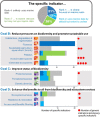Zooplankton monitoring to contribute towards addressing global biodiversity conservation challenges
- PMID: 30279615
- PMCID: PMC6159525
- DOI: 10.1093/plankt/fby030
Zooplankton monitoring to contribute towards addressing global biodiversity conservation challenges
Abstract
Oceanographers have an increasing responsibility to ensure that the outcomes of scientific research are conveyed to the policy-making sphere to achieve conservation and sustainable use of marine biodiversity. Zooplankton monitoring projects have helped to increase our understanding of the processes by which marine ecosystems respond to climate change and other environmental variations, ranging from regional to global scales, and its scientific value is recognized in the contexts of fisheries, biodiversity and global change studies. Nevertheless, zooplankton data have rarely been used at policy level for conservation and management of marine ecosystems services. One way that this can be pragmatically and effectively achieved is via the development of zooplankton indicators, which could for instance contribute to filling in gaps in the suite of global indicators to track progress against the Aichi Biodiversity Targets of the United Nations Strategic Plan for Biodiversity 2010-2020. This article begins by highlighting how under-represented the marine realm is within the current suite of global Aichi Target indicators. We then examine the potential to develop global indicators for relevant Aichi Targets, using existing zooplankton monitoring data, to address global biodiversity conservation challenges.
Keywords: Aichi Biodiversity Targets; EOVs; indicators; monitoring; zooplankton.
Figures



References
-
- Atkinson A., Siegel V., Pakhomov E. and Rothery P. (2004) Long-term decline in krill stock and increase in salps within the Southern Ocean. Nature, 432, 100–103. doi:10.1038/nature02950.1. - DOI - PubMed
-
- Balino B. M., Fasham M. J. R. and Bowles M. C. (2001) Ocean biogeochemistry and global change. IGBP Sci., 2, 1–34.
-
- Barange M., Field J. G., Harris R. P., Hofmann E. E., Perry R. I. and Werner F. E. (2010) Marine Ecosystems and Global Changes. Oxford University Press, New York.
-
- Batten S., Clark R., Flinkman J., Hays G., John E., John A. W., Jonas T., Lindley J. A. et al. (2003) CPR sampling: the technical background, materials and methods, consistency and comparability. Prog. Oceanogr., 58, 193–215. doi:10.1016/j.pocean.2003.08.004. - DOI
-
- Batten S. D. and Walne A. W. (2011) Variability in northwards extension of warm water copepods in the NE Pacific. J. Plankton Res., 33, 1643–1653. doi:10.1093/plankt/fbr065. - DOI

